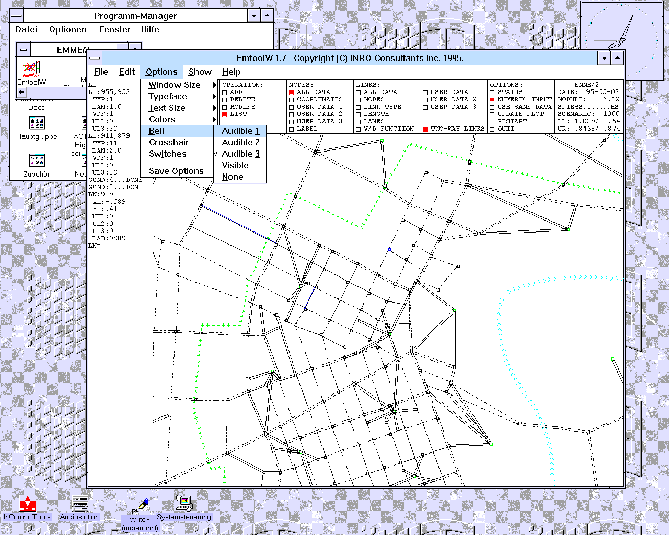
INRO is proud to announce the introduction of EmtoolW, a new implementation of the EMTOOL interface which operates under Microsoft Windows 3.x.
For PC users doing most of their work under Windows,
EmtoolW is an attractive alternative to the currently used DOS implementation
EMTOOL.EXE.
While the latter can be used under Windows only in a full screen DOS
window, EmtoolW allows running an EMME/2 session directly on the Windows
desktop. With this new development, EMME/2 users on PCs, too, will now be able to
benefit from the advantages of working on a windowed desktop --
something to which UNIX and VMS users have had access
for quite some time with EmtoolX, the X-11 implementation of EMTOOL.
EmtoolW is designed to be 100% compatible with the current Release 7
binaries. In this way, it can be distributed as an incremental add-on,
without having to wait for a new major EMME/2 software release.
It can be installed on top of any standard EMME/2 MS-DOS installation,
without need for special configurations of the application data banks.
Therefore, installing EmtoolW under Windows does not preclude still
using EMTOOL.EXE for sessions that are run under DOS without Windows.
Under EmtoolW, EMME/2 works exactly in the same manner as usual, except that all input and output appears within the EmtoolW window. The operation of EmtoolW itself can be controlled by the commands available via the menu bar located just below the window caption. Various options regarding window size, typeface, text size, colors and bell sounds can be used to configure the appearance of EmtoolW. The usual ``Copy'' and ``Paste'' commands allow exchanging of text and graphic bitmap information with the Clipboard. The ``Print'' command can be used to send the current contents of the EmtoolW window to the printer. A special ``Show last plot'' command temporarily recalls the last plot or report page when in dialog mode.
While theoretically it is possible to run EmtoolW on any PC on which Windows is installed, it is really aimed at installations with resolutions of 1024x768 or higher. From an implementational point of view, the ``optimal'' recommended configuration would consist of a screen resolution of 1280x1024 on which EmtoolW is using an 1024x780 window size, as this window size minimizes the scaling overhead and avoids the minor rounding effects which might sometimes be caused by coordinate scaling.
The speed at which
graphics are displayed under EmtoolW is not only a function of
the type of graphic processor used, but depends also very much on
the efficiency of the Windows display driver provided with it. Thus,
there is no direct relationship between the performances of EmtoolW
and EMTOOL.EXE, even if run on the same installation.
On old unaccelerated graphic boards, EmtoolW may run up to two times
slower than EMTOOL.EXE (due to the overhead introduced by Windows),
whereas on most of today's highly advanced graphic boards, EmtoolW
is the clear winner. The overall overhead for running CPU intensive
EMME/2 tasks (e.g. assignments or matrix convolutions) within EmtoolW,
depends of course on the other Windows programs
active at the same time;
but it is usually limited to a few percent
compared to running the same task directly under DOS.
Note that EmtoolW is assumed to be installed on systems
which run MS-DOS 6.0 or higher, but limited support for running under
MS-DOS 5.x is provided as well.

If combined with a remote access software, such as Kermit or Telnet, EmtoolW can also be used to run an EMME/2 session over the network on remote UNIX or VMS hosts. This way, multi-user sites can let local users access their EMME/2 system from standard PCs, giving them the comfort of a window environment, without the need for expensive X-terminals or emulation software.
EmtoolW has been extensively tested with MS Windows 3.1, 3.11 and Windows for Workgroups 3.11. Initial tests have also shown it to work with the final beta release of Windows 95 (even though the performance did not quite meet our expectations).
Since one main goal of the initial version of EmtoolW was to provide an EMTOOL interface for Microsoft Windows 3.x that works with the current software release, this excluded the possibility of adding any features which would require modifications to the EMME/2 system itself. For future EMME/2 releases, however, this restriction will no longer apply, so that then it will become possible to enhance EmtoolW (as well as other EMTOOL implementations) by providing possibilities for more and tighter interactions with the individual EMME/2 modules.
The distribution of EmtoolW should already have started by the time you
read this EMME/2 NEWS. In fact, you might even have received your EmtoolW
kit with the same mailing.